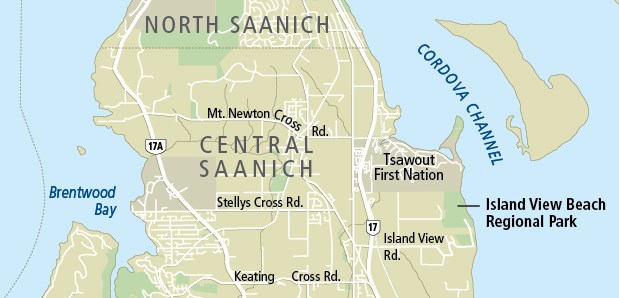While the rest of the country — shovelling and shivering — can only dream of being outside in short sleeves, Central Saanich has discovered that early February is the best time to get the jump on mosquitoes.
“It’s a very unique place,” Curtis Fediuk, operations manager for D.G. Regan and Associates, the Port Moody contractor hired to wage war with the pests, told Central Saanich council this week.
“We travel all over B.C. and the Yukon, and there’s nowhere where you control mosquitoes on Feb. 9. It just doesn’t happen.”
Fediuk named exposure, sunlight and soil composition that retains heat as possible factors in promoting early breeding.
Another factor may be the area’s types of water, including fresh, brackish and salt.
Whatever it is, mosquitoes love it.
Fediuk said there are eight to 12 species of mosquitoes in the marshes and farmland near Island View Beach, compared with 22 on the whole of the Lower Mainland.
The early hatching is no secret to longtime Central Saanich resident Lea Van Stolk, who told councillors that one year, she marked Feb. 4 on her calendar as the day she swatted her first mosquito of the season.
Fediuk said if he hadn’t experienced it, he never would have believed it. Three years ago, while in Victoria for interviews at the University of Victoria, he said, he went to the marsh Feb. 9 and found mosquitoes everywhere.
“I’ve never seen anything like it. Since that time, we’ve been working starting in February.”
And things have been getting better. “It acted like a light switch,” Fediuk said of the dramatic drop in mosquito numbers. “That’s purely because we started early.”
The greatest sources of mosquitoes in Central Saanich are the large salt marsh and old farm fields on its eastern edge, stretching from the Tsawout First Nation to the Island View Beach Regional Park.
About 145 hectares on private and public properties were treated with the biological control agent VectoBac between February and the end of August last year.
A couple of years ago, it was discovered that drainage ditches built in 1936 and designed to drain flatlands around the beach to control mosquitoes had not been properly maintained by the Capital Regional District.
Last year, Central Saanich arranged for the ditches to be cleaned and the CRD paid for the work. The CRD has since agreed to continue to maintain them.
Clearing ditches and draining stagnant water is vital to getting the problem bloodsuckers under control, because it reduces breeding habitat, Fediuk said. “Where there’s no water, there’s no mosquitoes.”
But it’s the early start on abatement efforts — months ahead of anywhere else in B.C. — that has been key, he said.
Residents couldn’t be happier.
“We all are saying the same thing. We look at each other with wonderment and say: ‘There’s no mosquitoes,’ ” said Jason Austin, a 22-year resident. He said last year was the first year there were no mosquitoes.
The more-than-$55,000 cost of the abatement program is shared by Central Saanich, the Tsawout and the CRD. It includes public education, species surveillance, mapping, habitat monitoring and larvicide treatments.



